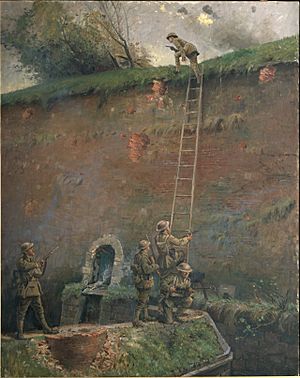Battle of the Sambre (1918) facts for kids
Quick facts for kids Battle of the Sambre (1918) |
|||||||
|---|---|---|---|---|---|---|---|
| Part of the Western Front of World War I | |||||||
 The scaling of the walls of Le Quesnoy by New Zealand troops; painting by George Edmund Butler |
|||||||
|
|||||||
| Belligerents | |||||||
|
|||||||
| Strength | |||||||
| 37 tanks | |||||||
| Casualties and losses | |||||||
| Unknown | Unknown | ||||||
The Second Battle of the Sambre happened on November 4, 1918. It was a major fight near the end of World War I. This battle was part of the final big attacks by the Allied forces in Europe. It also included smaller fights known as the Second Battle of Guise and the Battle of Thiérache.
Contents
Why This Battle Happened
By late 1918, German forces were getting weaker. Many German soldiers were captured in earlier battles. The Allied armies saw a chance to push forward. They quickly planned a new attack.
The plan was for the French First Army and the British First, Third, and Fourth Armies to advance. They would move about 48 kilometers (30 miles) towards the cities of Maubeuge and Mons. Their goal was to threaten Namur. This move would make it hard for the Germans to set up new defenses.
On November 4, 1918, the attack began at dawn. Seventeen British divisions, including Canadian troops, joined the fight. Eleven French divisions also took part. There were only 37 tanks available to help, as many had been used in earlier battles.
Crossing the Sambre Canal
The first big challenge for the northern Allied forces was the Sambre Canal. This canal was 18 to 21 meters (60-70 feet) wide. The ground around it was also flooded. This was the same area where British forces had fought four years earlier.
British troops from the XIII and IX Corps reached the canal first. German cannons fired heavily at them. Soldiers tried to put temporary bridges in place under intense fire. Many soldiers were lost during this dangerous crossing. For example, the 1st and 32nd Divisions lost about 1,150 men. The famous war poet Wilfred Owen was among those who died.
Even after crossing the canal, German forces fought hard. They defended small villages and fields. It took until midday to create a breakthrough. The Allies managed to secure a gap about 3 kilometers (2 miles) deep and 24 kilometers (15 miles) wide. Lieutenant Colonel Dudley Graham Johnson earned a special medal, the Victoria Cross, for bravely leading his troops across the canal.
Fighting in the Forests and Towns
Further north, other British forces attacked the Forêt de Mormal (Mormal Forest). Canadian troops moved towards Mons. The German defense was not always strong. Some British units, like the 13th Royal Welsh Fusiliers, hardly needed to use their guns. However, other units faced fierce resistance. For example, the 9th Battalion of the 17th Division lost most of its officers and many soldiers.
Despite these challenges, the Allied advance continued. The main goals of the battle were met on November 4 or the next day. The town of Le Quesnoy, located west of Mormal Forest, was captured by the New Zealand Division.
To the south, the French First Army also attacked. They captured the towns of Guise and Origny-en-Thiérache. These actions were known as the Second Battle of Guise and the Battle of Thiérache.
After the Battle
The battle created a large area of control for the Allies. It was almost 80 kilometers (50 miles) long and 3 to 5 kilometers (2-3 miles) deep. From this point, the northern Allied armies pushed forward without stopping. They sometimes advanced more than 8 kilometers (5 miles) a day. This continued until the Armistice Line was reached on November 11, 1918. This line stretched from Ghent through several towns in Belgium.
Images for kids


